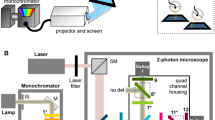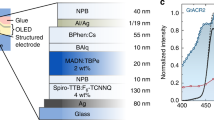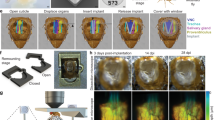Abstract
The nervous system of Drosophila is widely used to study neuronal signal processing because the activities of neurons can be controlled and monitored by cell type–specific expression of genetically encoded actuator and sensor proteins. Measuring neural activities in adult flies, however, usually requires surgical approaches to penetrate the firm and pigmented cuticular exoskeleton. Interfering with this exoskeleton is critical in the case of the peripheral nervous system (PNS), as sensory neurons are often located directly beneath the cuticle and are associated with specialized stimulus-receiving and -conducting cuticular structures. In this article, we describe how the activities of these neurons can be probed nondestructively through the cuticle if a genetically encoded fluorescent protein sensor with strong baseline fluorescence is used. The method is exemplified for mechanosensory neurons in the adult antenna but can also be applied to many other PNS neurons, as is shown for the femoral chordotonal organ located in the fly's leg.
This is a preview of subscription content, access via your institution
Access options
Subscribe to this journal
Receive 12 print issues and online access
$259.00 per year
only $21.58 per issue
Buy this article
- Purchase on Springer Link
- Instant access to full article PDF
Prices may be subject to local taxes which are calculated during checkout



Similar content being viewed by others
References
Sokolowski, M.B. Drosophila: genetics meets behaviour. Nat. Rev. Genet. 2, 879–890 (2001).
Olsen, S.R. & Wilson, R.I. Cracking neural circuits in a tiny brain: new approaches for understanding the neural circuitry of Drosophila. Trends Neurosci. 31, 512–520 (2008).
Brand, A.H. & Perrimon, N. Targeted gene expression as a means of altering cell fates and generating dominant phenotypes. Development 118, 401–415 (1998).
Duffy, J.B. GAL4 system in Drosophila: a fly geneticist's Swiss army knife. Genesis 34, 1–15 (2002).
McGuire, S.E., Roman, G. & Davis, R.L. Gene expression systems in Drosophila: a synthesis of time and space. Trends Genet. 20, 384–391 (2004).
Nitabach, M.N., Blau, J. & Holmes, T.C. Electrical silencing of Drosophila pacemaker neurons stops the free-running circadian clock. Cell 109, 485–495 (2002).
Sweeney, S.T., Broadie, K., Keane, J., Niemann, H. & O'Kane, C.J. Targeted expression of tetanus toxin light chain in Drosophila specifically eliminates synaptic transmission and causes behavioral defects. Neuron 14, 341–351 (1995).
Kitamoto, T. Targeted expression of temperature-sensitive dynamin to study neural mechanisms of complex behavior in Drosophila. J. Neurogenet. 16, 205–228 (2002).
Schroll, C. et al. Light-induced activation of distinct modulatory neurons triggers appetitive or aversive learning in Drosophila larvae. Curr. Biol. 16, 1741–1747 (2006).
Suh, G.S. et al. Light activation of an innate olfactory avoidance response in Drosophila. Curr. Biol. 17, 905–908 (2007).
Zhang, W., Ge, W. & Wang, Z. A toolbox for light control of Drosophila behaviors through Channelrhodopsin 2-mediated photoactivation of targeted neurons. Eur. J. Neurosci. 26, 2405–2416 (2007).
Pulver, S.R., Pashkovski, S.L., Hornstein, N.J., Garrity, P.A. & Griffith, L.C. Temporal dynamics of neuronal activation by Channelrhodopsin-2 and TRPA1 determine behavioral output in Drosophila larvae. J. Neurophysiol. 101, 3075–3088 (2009).
Fiala, A. & Spall, T. In vivo calcium imaging of brain activity in Drosophila by transgenic cameleon expression. Sci. STKE 174, PL6 (2003).
Miyawaki, A. Fluorescence imaging of physiological activity in complex systems using GFP-based probes. Curr. Opin. Neurobiol. 13, 591–596 (2003).
Reiff, D.F. et al. In vivo performance of genetically encoded indicators of neural activity in flies. J. Neurosci. 25, 4766–4778 (2005).
Jayaraman, V. & Laurent, G. Evaluating a genetically encoded optical sensor of neural activity using electrophysiology in intact adult fruit flies. Front. Neural. Circuits 1, 3 (2007).
Hendel, T. et al. Fluorescence changes of genetic calcium indicators and OGB-1 correlated with neural activity and calcium in vivo and in vitro. J. Neurosci. 28, 7399–7411 (2008).
Vosshall, L.B. & Stocker, R.F. Molecular architecture of smell and taste in Drosophila. Annu. Rev. Neurosci. 30, 505–533 (2007).
Borst, A. Drosophila's view on insect vision. Curr. Biol. 19, 36–47 (2009).
Amrein, H. & Thorne, N. Gustatory perception and behavior in Drosophila melanogaster. Curr. Biol. 15, 673–684 (2005).
Kamikouchi, A. et al. The neural basis of Drosophila gravity-sensing and hearing. Nature 458, 165–171 (2009).
Yorozu, S. et al. Distinct sensory representations of wind and near-field sound in the Drosophila brain. Nature 458, 201–205 (2009).
Fiala, A. Olfaction and olfactory learning in Drosophila: recent progress. Curr. Opin. Neurobiol. 17, 720–726 (2007).
Fiala, A. et al. Genetically expressed cameleon in Drosophila melanogaster is used to visualize olfactory information in projection neurons. Curr. Biol. 12, 1877–1884 (2002).
Wang, J.W., Wong, A.M., Flores, J., Vosshall, L.B. & Axel, R. Two-photon calcium imaging reveals an odor-evoked map of activity in the fly brain. Cell 112, 271–282 (2003).
Wang, Y. et al. Stereotyped odor-evoked activity in the mushroom body of Drosophila revealed by green fluorescent protein-based Ca2+ imaging. J. Neurosci. 24, 6507–6514 (2004).
Marella, S. et al. Imaging taste responses in the fly brain reveals a functional map of taste category and behavior. Neuron 49, 285–295 (2006).
Turner, S.L. & Ray, A. Modification of CO2 avoidance behaviour in Drosophila by inhibitory odorants. Nature 461, 277–281 (2009).
de Bruyne, M., Foster, K. & Carlson, J.R. Odor coding in the Drosophila antenna. Neuron 30, 537–352 (2001).
Dobritsa, A.A., van der Goes van Naters, W., Warr, C.G., Steinbrecht, R.A. & Carlson, J.R. Integrating the molecular and cellular basis of odor coding in the Drosophila antenna. Neuron 37, 827–841 (2003).
Moon, S.J., Lee, Y., Jiao, Y. & Montell, C. A Drosophila gustatory receptor essential for aversive taste and inhibiting male-to-male courtship. Curr. Biol. 19, 1623–1627 (2009).
Albert, J.T., Nadrowski, B. & Göpfert, M.C. Mechanical signatures of transducer gating in the Drosophila ear. Curr. Biol. 17, 1000–1006 (2007).
Eberl, D.F., Hardy, R.W. & Kernan, M.J. Genetically similar transduction mechanisms for touch and hearing in Drosophila. J. Neurosci. 20, 5981–5988 (2000).
Miyawaki, A., Griesbeck, O., Heim, R. & Tsien, R.Y. Dynamic and quantitative Ca2+ measurements using improved cameleons. Proc. Natl Acad. Sci. USA 96, 2135–2140 (1999).
Diegelmann, S., Fiala, A., Leibold, C., Spall, T. & Buchner, E. Transgenic flies expressing the fluorescence calcium sensor Cameleon 2.1 under UAS control. Genesis 34, 95–98 (2002).
Pelz, D., Roeske, T., Syed, Z., de Bruyne, M. & Galizia, C.G. The molecular receptive range of an olfactory receptor in vivo (Drosophila melanogaster Or22a). J. Neurobiol. 66, 1544–1563 (2006).
Kamikouchi, A., Shimada, T. & Ito, K. Comprehensive classification of the auditory sensory projections in the brain of the fruit fly Drosophila melanogaster. J. Comp. Neurol. 499, 317–356 (2006).
Kim, J. et al. A TRPV family ion channel required for hearing in Drosophila. Nature 424, 81–84 (2003).
Sharma, Y., Cheung, U., Larsen, E.W. & Eberl, D.F. PPTGAL, a convenient Gal4 P-element vector for testing expression of enhancer fragments in Drosophila. Genesis 34, 115–118 (2002).
Albert, J.T., Nadrowski, B., Kamikouchi, A. & Göpfert, M.C. Mechanical tracing of protein function in the Drosophila ear. Nat. Protoc. [online] doi:10.1038/nprot.2006.364 (2006).
Nadrowski, B., Albert, J.T. & Göpfert, M.C. Transducer-based force generation explains active process in Drosophila hearing. Curr. Biol. 18, 1365–1372 (2008).
Göpfert, M.C. & Robert, D. The mechanical basis of Drosophila audition. J. Exp. Biol. 205, 1199–1208 (2002).
Acknowledgements
We thank J.T. Albert, E. Buchner, M. Dübbert, K. Ito, K. Öchsner and T. Völler for fly strains and technical support. This work was supported by the Alexander von Humboldt Foundation and the Japan Society for the Promotion of Science (to A.K.); the DFG Research Centre for the Molecular Physiology of the Brain, the Volkswagen-Foundation and the BMBF Bernstein Network for Computational Neuroscience (to M.C.G.); and the DFG (SFB 554 to A.F.).
Author information
Authors and Affiliations
Contributions
A.K. and M.C.G. designed the experiments; A.K., T.E., R.W. and A.F. conducted the experiments. A.K., M.C.G and A.F. wrote the article. M.C.G and A.F. supervised the work. All authors discussed the concepts and results, and commented on the article.
Corresponding authors
Ethics declarations
Competing interests
The authors declare no competing financial interests.
Rights and permissions
About this article
Cite this article
Kamikouchi, A., Wiek, R., Effertz, T. et al. Transcuticular optical imaging of stimulus-evoked neural activities in the Drosophila peripheral nervous system. Nat Protoc 5, 1229–1235 (2010). https://doi.org/10.1038/nprot.2010.85
Published:
Issue Date:
DOI: https://doi.org/10.1038/nprot.2010.85
This article is cited by
-
Mechanosensory interactions drive collective behaviour in Drosophila
Nature (2015)
-
Neuronal encoding of sound, gravity, and wind in the fruit fly
Journal of Comparative Physiology A (2013)
Comments
By submitting a comment you agree to abide by our Terms and Community Guidelines. If you find something abusive or that does not comply with our terms or guidelines please flag it as inappropriate.



